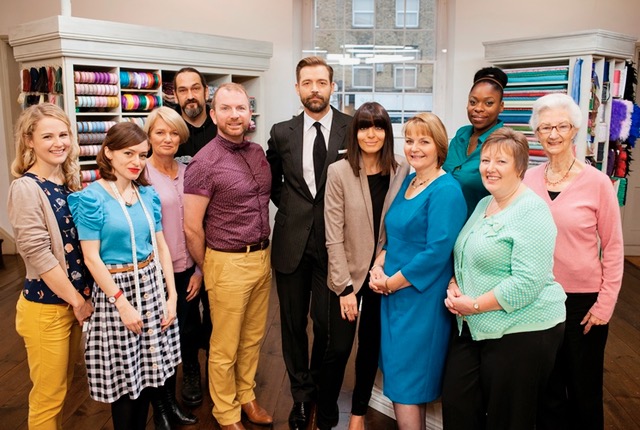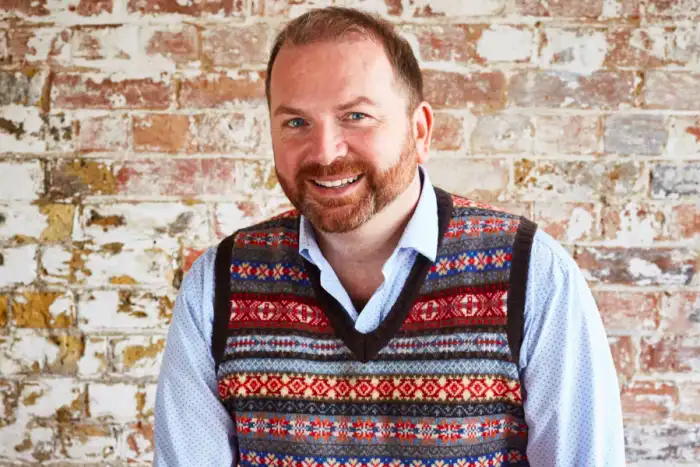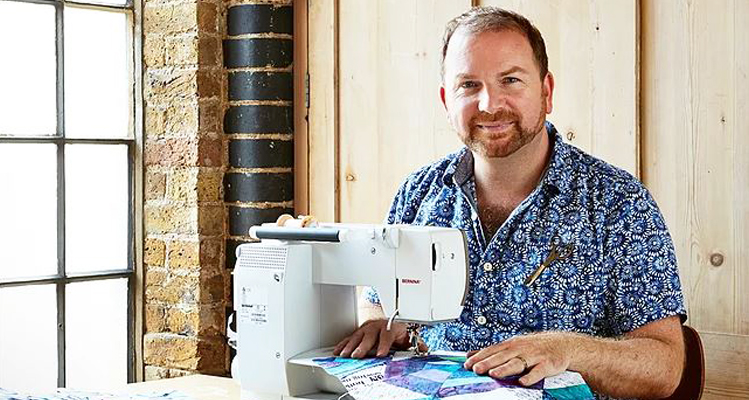
Great British Sewing Bee Series 1.
Photos courtesy of Stuart Hillard
“Have you ever thought about going on the Sewing Bee?” If you sew, and you live in the UK, it’s likely someone has asked you this question.
All of us who have watched the Great British Sewing Bee can understand why people would ask sewers about our desire to join this cult series. The show has created careers and celebrity-like status for some of those who have taken part. It generated a resurgence in the sewing industry that caught most of the outside world by surprise, and when the series was threatened with a rumored cancellation in 2017, it was met with a fierce backlash.
Earlier this year, it was announced that Season 5 was back on the air for 2019—we rubbed our hands in glee at the thought of a fresh batch of contestants, new projects, skills, and eight weeks of conversations where we were allowed to overindulge our love of sewing.
But what is it really like to be a contestant on the series and what is it like to come out the other side? The first season had a smaller run of only four episodes (by comparison, the current season has eight) with the final episode of the first season peaking at over 3 million viewers. At one point during the season it was the most watched television program in the UK for the week it was aired.
A big part of the appeal was the individual personalities of the people involved—one of the more memorable ones being Stuart Hillard. While Hillard didn’t manage to make it to the final round, his bubbly personality showed through and he was described by the judges as the person who “brought the joy into sewing.” But even he was surprised by the reaction that the nation had with this quirky series.

Hillard reflects on the show’s success:
“I think we all knew that we had been part of something very special indeed, and I knew that if the final edited programs captured a fraction of that, the series would be a hit.
Love Productions, producer of both The Sewing Bee and The Bake Off are incredibly good at distilling the essence of two days of mayhem into one hour of TV…I don’t know how they do it. I knew that sewers and crafters would enjoy the show but I was really surprised by the more unlikely fans. I was stopped by two city gents in the financial district in London about a week after the series finished, both of whom were huge fans of the show…both told me they were made to watch by their wives but had been fascinated by the series.”
When the opportunity came for Hillard to put in his application, he never really thought he’d make it through the application-sifting process, but his decision to apply was made quickly. “I’d been writing for Popular Patchwork magazine for a few months and was speaking to a colleague who asked if I’d applied. At that point, I’d never heard of the show but within a couple of hours I filled in my application form and started my journey. I can’t tell you the number of times I’ve looked back on that moment as something really pivotal. You never know what one small decision might lead to.”
“I was at my husband’s family farm helping out and my phone rang with the news. I’d been through a lot of different auditions by then so I knew I was in with a pretty good chance of taking part, but when I knew for certain, I was elated and terrified in equal measure. I remember sitting at the train station a few weeks later waiting for the train to London to start filming thinking, ‘well you wanted this!’”

The filming of the series appears to thrive on chaos, but actually, the opposite is the case. “Everything behind the scenes is incredibly well organized, slick, and professional. I can honestly say that every single person involved in the filming was incredibly friendly, warm, kind, and supportive.
“It’s true, the competition is a real challenge and highly charged…there are occasional tears and the odd tantrum, but there are also a lot of laughs, a fair amount of banter, and great warmth and friendship. It’s a very supportive environment despite the obvious competition.”
For Hillard, the success of the series has also led to opportunities that he would have struggled to have access to had he never taken part. “I was already writing for a magazine and designing…I’d been teaching sewing for many years alongside my day job as a school teacher. I got my first book commissioned and the advance was enough to throw my hat into the ring and really commit to a career change. A number of high-profile companies approached me and asked me to work with them and before I knew it, I was working alongside Kaffe Fassett and Dame Zandra Rhodes. Like a snowball, the momentum picked up more amazing opportunities along the way.”
Stay tuned for Season 5 of The Great British Sewing Bee. It will no doubt be entertaining for both seasoned sewists and hobbyists new to the craft.
The Great British Sewing Bee is returning to the UK on BBC2 on Feb. 12, 2019.

Maeri Howard
contributor
Add one part crafty madam with an equal measure of a marketing and business sense, roll in a bit of a techy bootstrapping and you have what makes Maeri Howard tick. In 2009, she combined all of these to start a home-based craft business on a beautiful canal outside of Manchester, UK, called The Make and Do Studio. In 2013, The Make and Do Studio was chosen by the BBC as one of 20 small companies using the Internet to help their businesses stand out. As well as writing for the crafting industry, Maeri has spoken at various industry events about the changing face of creative businesses and how they can co-exist in a digital world.

Where can we watch this in the states? I have watched past seasons on YouTube but they are currently blocked.
Thanks!
The first series was the best by far and I loved it. Now I don’t and shall not be watching. Why? Too middle class, too little time to see good quality stitching (rushing and stressing the contestants far too much – I don’t want to see tears and overwhelm ), dull tasks and not really about enjoyable home sewing anymore. The rushing means we hardly get to see anything properly finished, which is frustrating for the sewers as well as me at home. Fast doesn’t mean best! Too many excellent and careful sewers end up leaving early because of this. Why does everything have to be a competition? Couldn’t we just see how everyone progresses?
Lots of nice friendly characters all kind and helpful to one another in the first couple of series but the rest not nearly so much. Quite a few of the contenders from the first series were memorable and a joy to watch (Stuart, Ann, Lauren, Tilly). I don’t care for the judging now and preferred the old team of judges and presenters. It’s become a frustrating programme to watch and I no longer care for it sadly.
So frustrating!!! Why get me all excited about the 2019 Show only to find out I cannot watch it in the US!!! Am I missing something?!
Hi Marie,
We do have an international readership and The Great British Sewing Bee is very popular in the UK. It’s definitely difficult to watch in the US. There were some episodes of the first season available on YouTube for a time. I’m honestly not sure if it’s possible to watch it outside of the UK.
As a UK reader/member, I appreciate the content that isn’t exclusivity US-focused. Thank you!
Try dailymotion.com. I’ve found it there, at least as of 02.12.19.
This show sounds much like the US version of Project Runway where garments are made in a day or two then judge on the runway by a panel of regulars and always a guest judge.
Not really. Project Runway is all Glamour, high drama, flashy, cutting comments, thin and tall models strutting down the catwalk…very American. Enjoyable if you like that sort of thing. But the Sewing bee is more home sewing, twee (not in a bad way), everyday people, and just…very British 😀
Loved and watched all the shows but would like to see more sewing techniques explained. Also, time to see more of the finished garments.